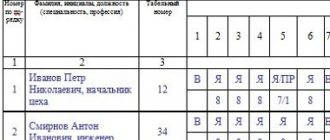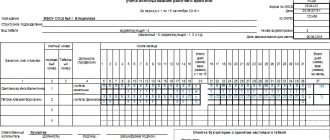Trade and its types
Trade “in general” is the resale of any material assets. A businessman buys goods and then sells them at higher prices.
The following types of trade are distinguished:
- Wholesale. In this case, goods are usually sold in large quantities. Sometimes - not very large, but in any case it is not a single product. As a rule, both the seller and the buyer in wholesale sales are legal entities or individual entrepreneurs.
- Retail. This is the sale of goods individually or in small quantities. Buyers here are usually individuals.
- Commission. It is carried out within the framework of both retail and wholesale trade. In this case, the seller (commission agent) receives the goods from its owner (committent) and sells them to third parties for a fee.
Accounting in wholesale trade
To record the values sold, account 41 “Goods” is used.
Receipts of goods from the supplier are recorded in correspondence with account 60 “Settlements with suppliers and contractors”.
DT 41 – KT 60
If a businessman works on a general system, then the amount excluding VAT goes to account 41, and the tax itself is reflected in account 19.
DT 19 – CT 60
Purchasing goods often involves additional costs. These are transport services, loading, for imports – customs payments, etc. As a general rule, they should be included in the cost of the product using the same posting as its purchase price.
However, small businesses that qualify for simplified accounting may not allocate shipping costs to individual items. They have the right to attribute these amounts to current costs (clauses 13.1 - 13.3 PBU 5/01)
To account for current expenses, trade organizations use account 44 “Sales expenses”.
Services of third parties are reflected by postings:
DT 44 – KT 60 (76)
DT 19 – KT 60 (76) - when working with VAT
Thus, it is necessary to take into account not only delivery costs for small businesses, but also all other “external” services that are associated with the sale: advertising, packaging, insurance, etc.
Account 44 also takes into account the company’s internal costs: salaries, insurance premiums, depreciation of equipment, etc.
DT 44 – KT 70 (69.02...)
Sales in trade are reflected in account 90 “Sales” in correspondence with account 62 “Settlements with buyers and customers”.
DT 62 – KT 90.1 – goods shipped
DT 90.3 – KT 68.2 – VAT charged on sales
DT 90.2 – KT 41 – cost of goods sold written off
DT 90.2 – KT 44 – current sales expenses written off
DT 51 (52.50) – CT 62 – payment received from the buyer
Accounting for goods in retail trade: how to receive them correctly
Retail stores usually deal with a large volume of heterogeneous goods, so it is important to establish accounting from the beginning to avoid further misunderstandings. Automation of actions helps to perform such tasks as monitoring the safety of inventory items, timely receipt of information about the volume of warehouse stocks, and calculating the profitability of each batch.
Automated accounting has a number of advantages:
- Promptly obtaining information on the sales range for each product. The owner of a retail outlet has access to information about the profitability of all items, which gives him the opportunity not to increase the volume of stale products.
- Control over quantitative availability reduces the level of theft.
- Possibility of quick inventory taking.
- Improve customer service by providing prompt customer assistance.
Accounting tasks also include:
- pricing control;
- checking the execution of trade transactions;
- setting tasks for the financially responsible person regarding the safety of valuables;
- timely detection of defects and delays;
- carrying out inventory;
- calculation of income received.
The organization independently develops accounting policies affecting trading operations. Violation of the principles of accounting for goods can lead to a decrease in profits and the formation of shortages.
The purchase of goods for retail trade is carried out through intermediaries or directly from manufacturers. In addition, the store owner has the right to offer his own products.
Valuables arriving from outside must have accompanying documents. They contain basic data about the product, supplier, and carrier. If we are talking about an imported product, you need a conclusion from the State Sanitary and Epidemiological Supervision on proper quality, first of all this applies to food products.
The process of receipt of goods is controlled by materially responsible persons. Products are credited to the warehouse at sales prices, then a markup is made that determines the final cost for further retail sales.
The structure of accounting in retail trade is somewhat different from wholesale sales. Owners have the right to independently decide by what rules to form records. It is allowed to record goods at sales prices, taking into account the allocation of a markup, or to generate purchasing analytics. The chosen method must be fixed in the accounting policy.
With automated work, the best solution would be to create quantitative and total accounting. That is, each type of inventory material is taken into account, and the write-off of cost is reflected at purchase prices.
We have prepared a detailed guide to organizing automated warehouse accounting for novice retail store owners.
Retail Accounting
Retailers have the right to keep inventory of goods in two ways:
- At purchase prices
With this option, revenue accounting is similar to wholesale trade. Each unit of goods is reflected in accounting based on the supplier's price and (if necessary) additional delivery costs.
DT 41 – KT 60
DT 19 – KT60
When selling at retail, the entire amount of revenue received per day is reflected in account 90. Correspondence here can be with account 50 when selling for cash or with accounts 51 or 57 “Transfers in transit” when using acquiring. The need to use account 57 is due to the fact that many banks do not immediately credit incoming non-cash proceeds to the businessman’s account.
DT 50 (51.57) – CT 90.1 – revenue accrued
DT 90.3 – KT 68.2 – VAT on revenue
DT 90.2 – KT 41 – cost of goods sold is written off.
- At sales prices
Unlike wholesalers, retailers know in advance at what price they will sell the product. Therefore, it is possible for them to record received goods at future sales prices. In this case, the cost of the goods “falls” into account 41, already taking into account the markup. And to the two receipt transactions discussed above, a third is added, using account 42 “Trade margin”.
DT 41 – KT 60
DT 19 – KT60
DT 41 – CT 42
Thus, a markup on them is added to the purchase price of goods, which is already reflected in account 41. The total amount of the markup for all purchased goods is “collected” on account 42.
Basic transactions for sales and cost accounting will also be similar to the first option. But in this case, on account 41, the goods are taken into account along with the markup, so the amount of written-off cost will be equal to the sales amount.
To highlight a businessman’s income, the cost of goods sold should be reduced by the amount of the markup on them. To do this, additional posting is required for the debit of account 42 and the credit of account 90.2
But account 42 is passive, so it cannot have a debit balance. Therefore, the necessary posting is carried out by “reversal”, i.e. with a minus sign. In accounting practice, such transactions are traditionally highlighted in red.
DT 90.2 - KT 42 (RESTORNO)
Accounting in retail trade
Retail trade involves the sale of valuables individually at a market price.
Accounting for receipt of valuables
Receipts can be recorded at purchase or sales prices. In the latter case, you need to allocate a markup. The chosen accounting method must be reflected in the accounting policy. If possible, records should be kept for each type of value. Such accounting is relevant when the company has special accounting programs. Such a program automatically writes off the cost of valuables at the purchase price. If the organization does not have the necessary tool, then accounting is carried out at selling prices. The markup is reflected in account 42 on the date of receipt of inventory items.
Let's consider the transactions that are relevant when reflecting inventory items at purchase prices:
- DT41 KT60. Receipt of products.
- DT19 KT60. Allocation of VAT.
Postings relevant when reflecting values at selling prices:
- DT41 KT60. Receipt of products.
- DT19 KT60. Allocation of VAT.
- DT41 KT42. Allocation of markup.
The markup is reflected in the retail price register. It is recommended to prepare a document for each receipt of goods.
Accounting for the realization of values
Proceeds from the sale of valuables are reflected in the credit of account 90/1. If the buyer pays using a bank card, this posting is used: DT51 (57) KT90/1. After revenue is reflected, it is necessary to take into account the disposal of valuables. This is done using wiring DT90/2 KT41.
It was mentioned earlier that accounting can be kept at purchase and selling prices. When selling inventory items, transactions are recorded depending on the selected accounting option. When reflecting the sale of goods at purchase prices, these entries are used:
- DT50 (51.57) KT90/1. Receiving proceeds from sales.
- DT90/3 KT68. VAT accrual.
- DT90/2 KT41. Write-off of the cost of inventory items.
When accounting at selling prices, the same transactions are needed. However, you need to additionally reflect the write-off of the markup. To do this, you need this wiring: DT90/2 KT42 (reversible).
Example of accounting in a trading company
specializes in wholesale trade of confectionery products. The organization has received goods. Direct costs included delivery of goods and materials. Confectionery products are sold. The sale included delivery costs. In this case, these postings are used:
- DT41 KT60. Receipt of valuables.
- DT19 KT60. Allocation of VAT.
- DT41 KT60. Accounting for delivery costs.
- DT19 KT69. Allocation of VAT on expenses.
- DT62 KT90/1. Sales of products.
- DT90/3 KT68. VAT on sales.
- DT90/2 KT41. Write-off of the cost of confectionery products.
- DT44 KT60. Accounting for delivery expenses.
- DT19 KT60. Input VAT.
- DT90/2 KT44. Write-off of costs for delivery of products to the buyer.
Based on accounting information, you can calculate the company's gross income.
Accounting in trade in case of damage to goods
With any type of trade, valuables in the warehouse sometimes lose their presentation. In such cases, account 94 “Shortages and losses from damage to valuables” should be used.
DT 94 – KT 41 – damage to goods detected
Further operations depend on whether the amount of losses “fits” the established norms of natural loss and whether the culprit is found.
DT 44 – KT 94 – write-off within the limits of natural loss
DT 73 – CT 94 – losses attributed to the guilty party
DT 91 – CT 94 – excess losses are written off as losses (if the culprit is not found)
If accounting in account 41 was carried out taking into account the markup, then it would be incorrect to write it off as losses on damaged goods, since the company did not receive this income. Therefore, one more additional wiring will be required.
DT 94 – KT 42 (STORNO)
Accounting in commission trade
Accepting goods on commission is something between trade and services. The commission agent sells the goods of the principal and receives remuneration from him for this.
- Accounting with a commission agent
The commission agent does not become the owner of the valuables being sold, therefore he takes into account their receipt off the balance sheet, in the debit of account 004.
When the goods are sold, revenue is reflected in the debit of account 62 (for wholesale trade) or accounts 50, 51 (for retail sales). Account 76 is credited, in which it is necessary to allocate a separate sub-account for settlements with principals.
DT 62 (50.51) - KT 76.1
The commission agent does not charge VAT. This tax is paid by the owner of the goods - the principal, if he has such an obligation.
At the same time, the goods sold must be written off to the credit of off-balance sheet account 004.
The commission agreement may provide that part of the commission agent's own expenses for the sale is reimbursed by the principal.
DT 76.1 – KT 60 (10,69,70...)
The remaining costs associated with the sale of consignment goods are borne by the commission agent himself.
DT 44 - CT 60 (10,69,70...)
The commission agent's remuneration is reflected in accounting as any provision of services.
DT 76.1 – KT 90.1
If the commission agent pays VAT, then this tax must also be charged.
DT 90.3 – KT 68.2
Next, you need to write off the commission agent's unreimbursed expenses for the sale.
DT 90.2 – KT 44
Based on the results of the transaction, the commission agent pays the principal the cost of the goods sold, minus his remuneration and reimbursable expenses.
DT 76.1 – KT 51 (50)
- Accounting with the principal
At the time of transfer of the goods to the commission agent, it should be reflected in account 45 “Goods shipped”.
DT 45 – CT 41
When the commission agent sells the goods, the principal must reflect this operation as a regular sale.
DT 62 – KT 90.1
DT 90.3 – KT 68.2
DT 90.1 – KT 45
The commission agent's remuneration, including VAT, and his reimbursable expenses must be taken into account by the principal as part of the sales expenses.
DT 44 – KT 60
DT 19 – CT 60
Retail trade transactions in accounting
The main operations when selling goods at retail are transferring goods for sale, recording revenue, writing off the cost of goods sold and expenses for their sale.
Let's look at typical retail transactions using examples.
Retail sales of purchased goods
Let's say Midshipman LLC purchased 45 units of flower pots at a price of 145 rubles per piece, VAT 22 rubles. The cost of delivery of goods from the seller (3800 rubles) is included in the price of the goods. During August 2015, Midshipman LLC sold all products at a retail price of 490 rubles. Selling expenses amounted to 2,400 rubles.
| Dt | CT | Description | Sum | Document |
| 60 | Midshipman LLC transferred funds to the supplier for the goods (45 units * 145 rubles) | 6525 rub. | Payment order | |
| 41/1 | 60 | The goods have been received into the warehouse | 6525 rub. | Packing list |
| 41/1 | 60 | Costs for transport company services are reflected | 3800 rub. | Agreement on transport services |
| 41/2 | 41/1 | The product was sent for sale to a flower shop | 6525 rub. | Sales Invoice |
| 44 | 76 | Selling expenses included | 2400 rub. | Expense report |
| 50 | 90/1 | The cash register received proceeds from the sale of goods (45 units * 490 rubles) | 22050 rub. | Implementation report |
| 90/2 | 41/2 | The cost of goods is reflected in expenses (RUB 6,525 + RUB 3,800) | 10325 rub. | Costing |
| 90/2 | 44 | Selling expenses reflected | 2400 rub. | Expense report |
| 90/9 | 99 | The financial result for August 2015 is reflected | 9325 rub. | Profit and Loss Statement |










